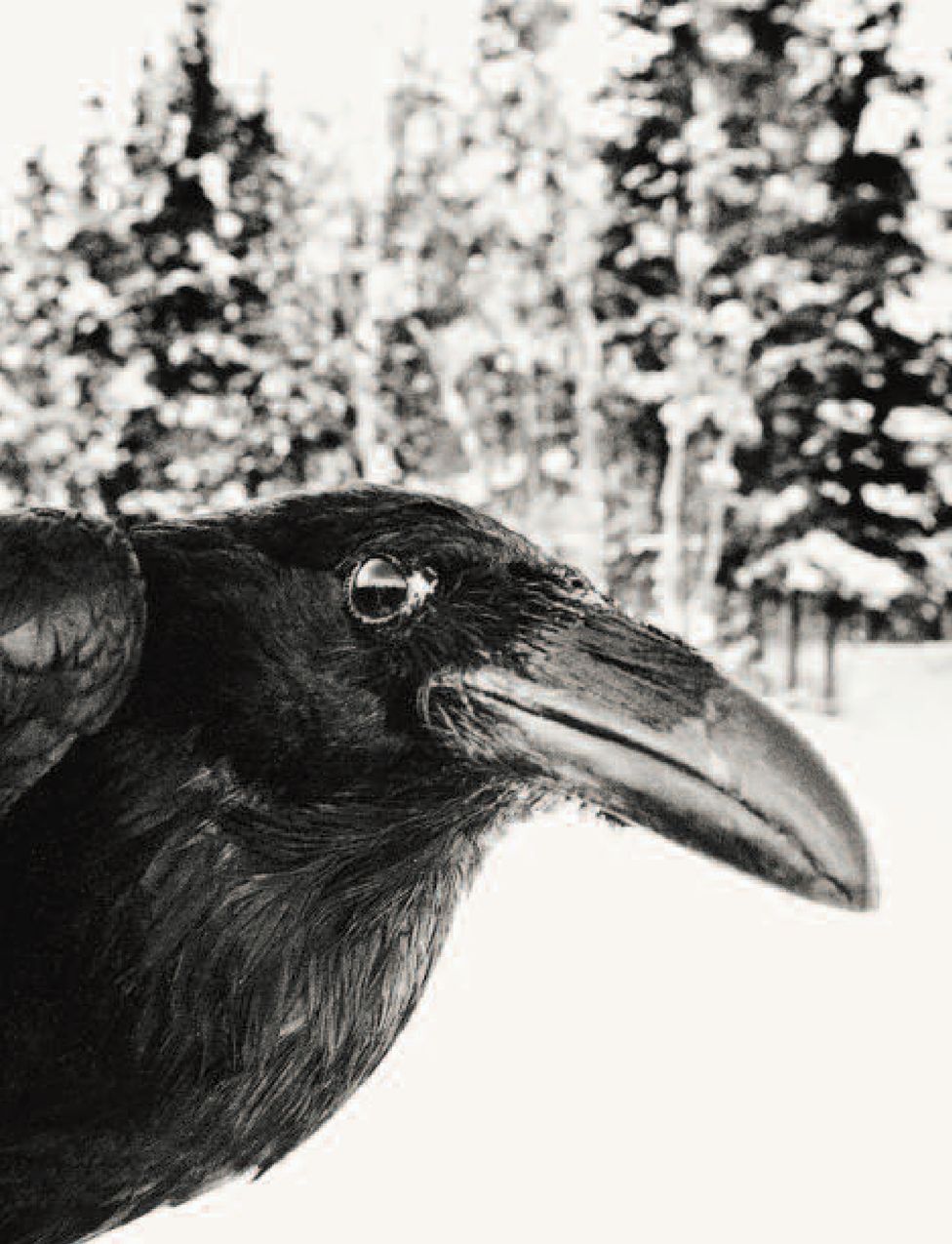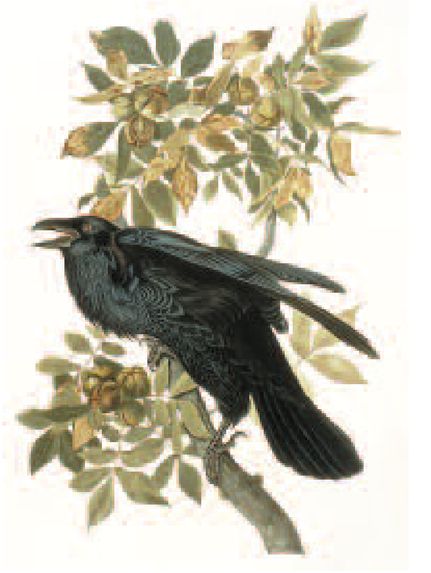Crows (9 page)
Authors: Candace Savage

As in North America, each family lives year-round on an exclusive territory. Although individuals may step out briefly to join a temporary flock at the garbage dump or to sleep at a communal roost, group members spend most of their time and meet most of their needs on the family
propiedad.
Not surprisingly, each group defends its holdings against invaders, which are expelled with vigorous chases and a machine-gun fire of caws. But if the in-comer is an older sibling that has dispersed and returned to visit for the afternoon, the residents greet it quietly and permit it to forage with them. Baglione suspects that the birds recognize family members that they have lived with in the past and are therefore able to distinguish between unwelcome intruders and welcome guests.
propiedad.
Not surprisingly, each group defends its holdings against invaders, which are expelled with vigorous chases and a machine-gun fire of caws. But if the in-comer is an older sibling that has dispersed and returned to visit for the afternoon, the residents greet it quietly and permit it to forage with them. Baglione suspects that the birds recognize family members that they have lived with in the past and are therefore able to distinguish between unwelcome intruders and welcome guests.
Carrion crow society is built on a web of male friendship. Females apparently disperse outside their family networks (and beyond the study
perimeters), but the males typically stay home with their parents for a year or two before scouting the neighborhood for a new place to live. By analyzing DNA from tagged crows, Baglione and his team have been able to show that dispersing males usually settle with their male relatives, perhaps birds they know from personal experience. (In one instance, a yearling checked out two territories, visiting each twice, before moving in with an older brother that had dispersed in the previous year.) So potent a force is brotherly love that both males often copulate with the one breeding female in the group, each fertilizing some of the clutch and giving new depth to the term “cooperative.”
perimeters), but the males typically stay home with their parents for a year or two before scouting the neighborhood for a new place to live. By analyzing DNA from tagged crows, Baglione and his team have been able to show that dispersing males usually settle with their male relatives, perhaps birds they know from personal experience. (In one instance, a yearling checked out two territories, visiting each twice, before moving in with an older brother that had dispersed in the previous year.) So potent a force is brotherly love that both males often copulate with the one breeding female in the group, each fertilizing some of the clutch and giving new depth to the term “cooperative.”
The question remains: How do they do it? How does a bird brain negotiate all these intricate social moves? Wouldn’t it be easier to believe that crows are clever robots, acting out a complex set of genetic instructions? To test this possibility, in 2001, Baglione and his collaborators transferred eggs from a mom-and-pop population in Switzerland, where helping is unknown, to the cooperative Spanish population, and vice versa. When Spanish chicks fledged in Switzerland, they immediately dispersed from their natal territory and joined temporary flocks of juveniles, just like all the other Swiss birds. But when Swiss crows grew up in Spain and were reared by cooperative family groups, five of the six surviving crows stayed home and became helpers. This pretty much lays to rest the idea of a simple genetic explanation and opens up new vistas for thought and speculation.

{ THREE }
The Trickster
REVISITED
REVISITED

 T
THE COMMON RAVEN is not, so far asanyone knows, an especially family-oriented bird. There is only one report of cooperative breeding in this species: a yearling raven in Minnesota that quixotically decided to stay home for an extra summer, guard its younger brothers and sisters in the nest, and occasionally accept feedings from its parents. As a rule, however, young ravens progress toward independence at a breakneck pace. In the few weeks between hatching (which occurs in early April to mid-May, depending on latitude) and fledging (mid-May to mid-June), a clutch of naked, floppy
pink gargoyles is miraculously transformed into a handsome brood of flapping, squawking, fully feathered juveniles. By July or August, these enterprising youngsters will have flown off their parents’ territory and set out to fend for themselves, at the ripe old age of four or five months.
Yet even after they make the break with home, these young vagabonds are not completely cut adrift from the company of other ravens. As the poet John Donne might have put it, had he been a bird-watcher, no raven is an island, entire of itself. Although a newly independent raven may pass its days alone, scouting the land for food, it is likely to spend the nights crowded in with dozens or even hundreds of its fellows at a communal roost. The largest roost on record, on a power transmission line in southwestern Idaho, attracted as many as 2,103 noisy, jostling ravens. It’s a kind of all-night party, attended by different birds on different nights, with frequent shifts of location, depending on the food supply. According to data from radio-tracking studies, each bird appears to operate independently, coming and going at will, as part of a complex and fluid network of acquaintances.
It may be here, in these avian nightclubs, that young ravens meet prospective mates and try out their courtship displays: jittery, dancelike routines of bowing, gurgling, knocking, fanning, tail spreading, and head fluffing. By age two, the birds may have chosen their lifelong partners, though they are not likely to reproduce until their third or fourth summers at the earliest. (One bird on record did not breed until his seventh year.) From then on, the members
of the pair spend most of their time on their territory, an area of between roughly 2 and 20 square miles that they occupy year-round and defend vociferously against other ravens. At night, partners typically roost near one another, often in the same tree, and often take time to preen each other, “kiss” with half-opened bills, and hold one another’s feet. On occasion, however, even these devoted homebodies fly off to sleep at a communal roost if the weather is severe or to join the greedy crowd that gathers to feast on a dead deer.
of the pair spend most of their time on their territory, an area of between roughly 2 and 20 square miles that they occupy year-round and defend vociferously against other ravens. At night, partners typically roost near one another, often in the same tree, and often take time to preen each other, “kiss” with half-opened bills, and hold one another’s feet. On occasion, however, even these devoted homebodies fly off to sleep at a communal roost if the weather is severe or to join the greedy crowd that gathers to feast on a dead deer.
➣
A raven in all its splendor calls to both eye and ear. This color engraving, by R. Havell, is based on a drawing by John J. Audubon.
A raven in all its splendor calls to both eye and ear. This color engraving, by R. Havell, is based on a drawing by John J. Audubon.

But just because ravens spend time with one another doesn’t mean they’re all sweetness and light. This is a species, remember, that is known in myth and legends from around the world as something of a rogue, and that spirit of malfeasance—that rascally inclination to prosper at another’s expense—also inflects the interactions of real-life ravens. The same female that snuggles up to her mate at night may sneak away the minute his back is turned and copulate with a neighbor. A juvenile feeding on a carcass may roll onto its back when other ravens fly overhead—as if to say, “I’m dead, guys; don’t risk it”—and then right itself and resume feeding when the potential competitors have left. (This behavior was noted by a trapper in central Saskatchewan and reported with a note of caution by biologist Bernd Heinrich in his 1995 book,
Mind of the Raven.
)
Mind of the Raven.
)

 Raven (Hooyeh) in Whale (Koone),
Raven (Hooyeh) in Whale (Koone),by Haida artist Johnny Kit Elswa, 1883.
RAVEN
gets his
WAY
gets his
WAY

AN ABRIDGED VERSION OF A STORY TOLD BY A TLINGIT MAN FROM WRANGELL, ALASKA—A MEMBER OF THE RAVEN CLAN—IN THE EARLY 1900S
R
aven saw a whale out at sea and he wanted to bring it into shore. So he took a knife and some fire-making equipment and flew into the whale’s mouth. For a time, he lived inside the whale, eating fish and the whale’s meat, but after he cut out the whale’s heart, the beast died and started to drift. Raven then sang his magic songs to bring the carcass onto a sandy beach, where his calls attracted the local people. When they cut the whale open, Raven escaped and flew off into the woods, crying “Q!one’, q!one’, q!one’.”
aven saw a whale out at sea and he wanted to bring it into shore. So he took a knife and some fire-making equipment and flew into the whale’s mouth. For a time, he lived inside the whale, eating fish and the whale’s meat, but after he cut out the whale’s heart, the beast died and started to drift. Raven then sang his magic songs to bring the carcass onto a sandy beach, where his calls attracted the local people. When they cut the whale open, Raven escaped and flew off into the woods, crying “Q!one’, q!one’, q!one’.”
Raven stayed away long enough for the people to render the whale’s fat into oil, boxes and boxes of it. When he returned, he pretended not to know what had happened. Where had the whale come from? he asked. Had the people heard a noise when it came ashore? Yes, they said, they had heard strange sounds and seen a dark shape flying away. “Years ago just such a thing as this happened,” Raven told them, “and all of the people who heard the noise died. You people must leave right away. Don’t eat anything. Leave it here.” So all of the people ran away, and Raven took all the oil.
Other books
One Whisper Away by Emma Wildes
The Texan by Bobbi Smith
Dirty by Kathryn Rose
A Widow's Hope by Mary Ellis
Broken Vessels (volume 2 of Jars of Clay) by Strauss, Lee, Elle Strauss
Must Love Fangs (Midnight Liaisons) by Sims, Jessica
A Frothy Fiasco: A Cozy Mystery (Sweet Home Mystery Series Book 3) by Constance Barker
The Song Is You by Megan Abbott
All Night Long by Melody Mayer
The Sword Bearer by John White
